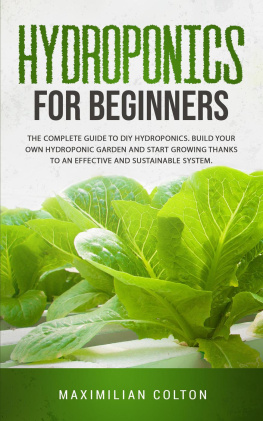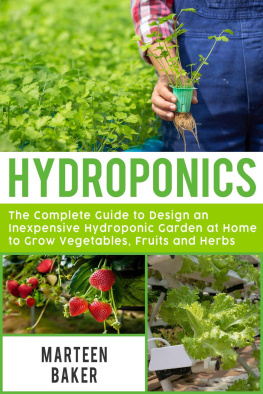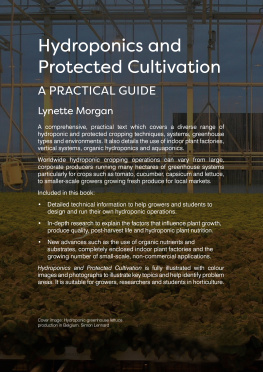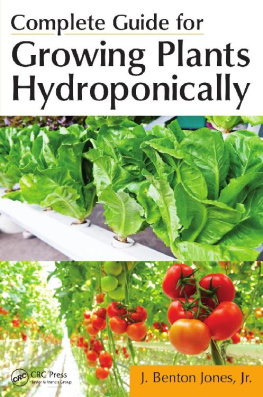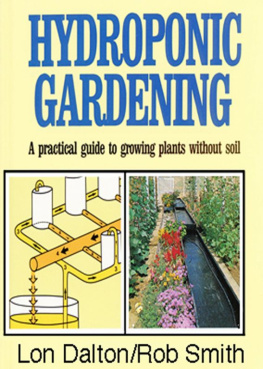HYDROPONIC CROP PRODUCTION
A growers guide to optimum crop production
"Published by Hydroponic DevelopmentsLtd at Smashwords,"
From the book by Lon Dalton & RobSmith
ePub edition 2013 Rob Smith
ISBN: 978-0-473-24882-6
PUBLISHED BY:
Hydroponic Developments Ltd onSmashwords
Hydroponic Crop Production
Hard copy and Epub editions
Copyright 2013 by Robin PhilipMorley-Smith
Acknowledgments
NZ Hydroponic International Ltd.(Formerly NZ Hydroponics Ltd.) For their-: Equipment, AnalyticalLaboratory services and research. Electronics laboratories andresearch. Seminars and management courses on Hydroponic cropproduction.
R.J.Hill Laboratories - Hamilton - NewZealand. For their additional advice on analyticalmatters.
The Authors also wish to sincerelythank all those individual growers, grower companies andHorticultural supply companies without who's co-operation thispublication would not have been possible.
Original hard copy book Layout andComputer Finished Art by Martine Cobb. Produced by Leonard CobbDirection Ltd. I2 Greenhill Crescent - Pakuranga - Auckland - NZ.Printed in Singapore by Kyodo Printing Co Pte Ltd.
PUBLISHINGDETAILS:
First Published in 1999 by NZHydroponics International Ltd. Revised ePub edition published byHydroponic Developments Ltd Tauranga - New Zealand Edited by RobSmith 2013
< >
Text and Computer Drawings 1999 and2013 by Rob Smith. Photography 1998 by Lon Dalton. All rightsreserved. No part of this publication may be reproduced stored inretrieval system, or transmitted in any form, or by any meanselectronic, mechanical photocopying, recurring or otherwise.without the prior written permission of the copyright holder, RobSmith.
eISBN: 978-0-473-24882-6
Beginners should also read Lon and Robsbest seller introduction to hydroponics titled HydroponicGardening which provides all the basic fundamentals leading up tothe technical support provided in this publication Hydroponic CropProduction
RobSmith
Rob commenced his apprenticeship in theElectrical Industry in 1956 and worked his way up in that industry,until he gained the highest Qualification of Technician/Inspectorin l97l. He has been involved with major Industrial ElectricalInstallations such as Export Cool Stores, and meat works, and inthe position of Consultant Electrical Engineer to Toyota (N.Z.)Ltd. being responsible for assembly Plant Automation Design. Earlyin I977 he was requested by a Fertilizer Company to design andbuild a commercial Hydroponic Controller, since none was availableWorld Wide.
After four months of intensive researchof the subject he set to and constructed the very first purposemade Hydroponic Controller, which was installed at the largest NewZealand Tomato Growers property at South Auckland NZ.
Since I977 Rob has continued to developsophisticated Electronic controls for all types of Industry.Hydroponics remains a strong love and their old company, nowrenamed and badged as BlueLab Corporation continues to produce awide range of Controllers, meters and systems with the emphasisbeing upon reliability and simplicity of operation. The worldrenowned CF Truncheon, Dipstick and Quickdip are good examplesof the technology Rob presented to the industry.
Now in the new millennium and also insemi retirement, Rob concentrates upon his love of performing Jazzon his Tenor Saxophone, however still continues to write, includinghaving been a regular contributor to the prestigious print versionof The Growing Edge magazine and consulting to theindustry.
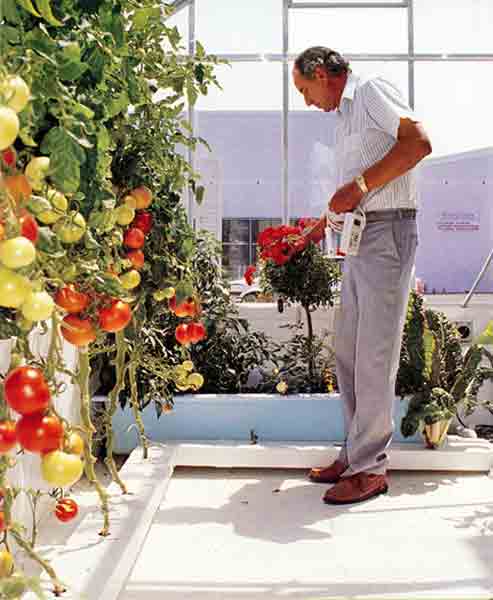
Rob in hydroponic greenhouse- Photo courtesy of Rosemary Wallace, Rotorua, NewZealand
Lon Dalton( 1926 - I999)
Lon was one of life's positivethinkers, he had always held an interest in the possibilities ofhydroponic gardening.
A man of many and varied pursuits inthe game of life, Lon had been a director of several successfulcompanies both in New Zealand and in the islands of thePacific.
Many years ago Lon decided to have a goat the subject that for so long had fascinated him, like so manyothers, he studied the information which had been published on thesubject, and proceeded to build his first hydroponic garden. Hishome was one big hydroponic garden, with every conceivable type ofsystem, growing the widest possible variety of plants, from grapes,limes and roses to potatoes, pumpkin and watercress. Lon becameinvolved with Rob Smith and between the two, NZ. Hydroponics wasformed, a company which would fill all the gaps that Lon had foundto his cost, faced anyone who wanted to get into the world ofhydroponics. This book continues to reflect much of Lonsenthusiasm and knowledge of the wonderful world ofHydroponics.
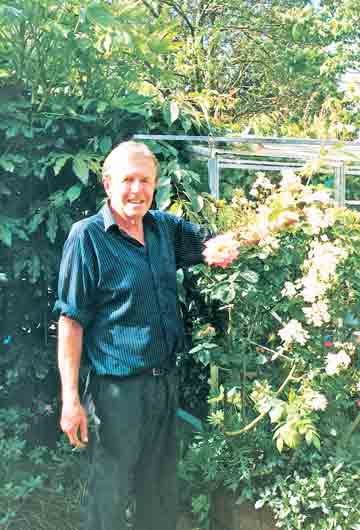
Lon Dalton 1926 1999
Foreword
Throughout this book I hope todemonstrate that hydroponics is more than just a scientificallycontrolled way of growing good fruit and vegetables. One of themajor incentives to use hydroponic growing methods is because itallows the grower to have greater control over so many of thetraditional problems associated with crop production. Pests anddiseases, weather problems including heavy rain, hail, wind etc,can all be conquered which allows the grower to consistentlyproduce greater volumes of fruit and vegetables of superiorquality. The use of modern hydroponic technology substantiallyreduces labour costs and not only results in significantefficiencies in the crop production process but also introduces ahigh level of environmental awareness.
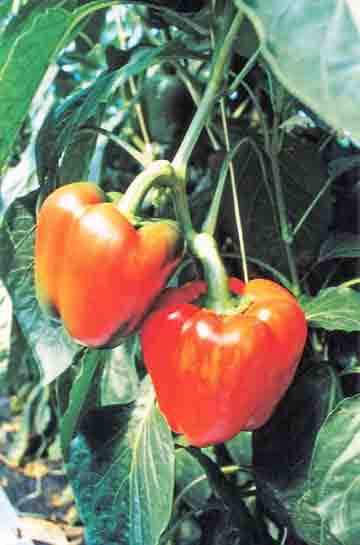
Capsicums growing in mediabags.
Hydroponics uses far less water thanconventional growing. Absolutely no herbicides are used and eventhe amount of insecticide and fungicides are constantly beingreduced. In some cases the need for protective, or remedialspraying has been virtually eliminated.
Today we live in an age where thelatest product becomes obsolete almost by the time you have arrivedhome! It is claimed that Asian manufacturers are actually producingobsolete technology, since they could never keep up with the floodof improvements which the back room boys keep feeding out to theproduction team. It would seem then, that mans ability to goforward is not restricted by his ingenuity only by the practicalaspects of gaining some financial return from the existingtechnology he has already invested in.
No one would argue against thetremendous advances that man has achieved in recent years, and itis very easy to become blas about many of thesetechnical
achievements. Who for example wouldreally wish to do without the labour saving devices which are socommonplace in both the home and the workplace.
With every advance in technology somedisadvantages always seem to appear, for example how manyconventional typists lost employment once the word processor becameestablished, and latterly one wonders how many people involved withthe processing of telegraphic communications are now, no longerneeded, as a result of the rapid introduction of email. These andmany other similar problems confront us everyday.
As technology becomes more advanced,the hydroponics industry is also presented with some of these newproblems. The increased use of electronics, automation andchemistry in intensive hydroponic production units, can present anintimidating spectre to many prospective growers.



